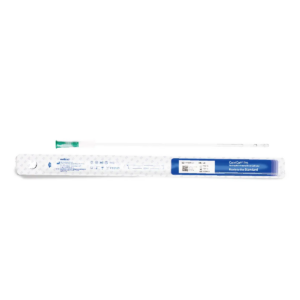When comparing hydrophilic catheter vs silicone catheter, the fundamental difference lies in their material technology and surface properties. A hydrophilic catheter like Well Lead Medical’s ConviCath Pro Ready-to-Use Male features a specialized coating that becomes lubricious when hydrated, creating a low-friction surface for smoother insertion. In contrast, a silicone catheter is made from flexible, biocompatible silicone material valued for its durability in long-term indwelling use.
The hydrophilic catheter vs silicone catheter comparison reveals distinct design approaches. While the hydrophilic catheter comes pre-lubricated with a water-activated coating for immediate use, the silicone catheter relies on its inherent material smoothness, often requiring additional lubrication for insertion. Well Lead Medical’s ConviCath Pro exemplifies hydrophilic technology with its integrated protective sleeve and adhesive tab, features not typically found on standard silicone catheters.

Clinical Applications and Usage Scenarios
The hydrophilic catheter vs silicone catheter debate becomes clearer when examining their intended applications. Hydrophilic catheters are primarily designed for intermittent catheterization, with Well Lead Medical’s products offering touch-free insertion and infection control advantages. The silicone catheter, with its flexible yet sturdy construction, is more commonly employed for indwelling catheterization lasting several weeks.
In the hydrophilic catheter vs silicone catheter usage comparison, healthcare providers note that hydrophilic options like ConviCath Pro are optimized for frequent, short-term use with their ready-to-use convenience. Meanwhile, silicone catheters are selected for extended drainage needs due to their material stability and biocompatibility. Well Lead Medical caters to both needs through specialized product lines meeting different clinical requirements.
Patient Comfort and Safety Considerations
The hydrophilic catheter vs silicone catheter discussion must address patient experience factors. Hydrophilic catheters generally provide greater comfort during insertion due to their lubricious coating, reducing urethral irritation—a key benefit of Well Lead Medical‘s ConviCath Pro
Regarding the hydrophilic catheter vs silicone catheter safety profile, both have distinct advantages. The hydrophilic catheter’s single-use nature minimizes infection risk, while the silicone catheter’s material properties reduce encrustation in long-term use. Well Lead Medical emphasizes proper product selection based on individual patient needs rather than promoting one type over another.
Conclusion: Selecting the Appropriate Catheter Solution
The comparison between hydrophilic catheters and silicone catheters highlights their distinct roles in urological care, each tailored for specific clinical applications. Well Lead Medical’s ConviCath Pro exemplifies the advanced features of modern hydrophilic catheters, specifically designed for intermittent catheterization. Its pre-lubricated, water-activated coating facilitates smooth insertion, making it ideal for short-term use. In contrast, silicone catheters are typically employed for long-term indwelling catheterization due to their durability and biocompatibility. They provide a reliable solution for extended drainage needs but may require additional lubrication for optimal insertion.
When selecting a catheter, medical professionals should consider the intended duration of use, the patient’s condition, and the specific clinical scenario. Well Lead Medical offers both hydrophilic and silicone catheter options, each manufactured to meet international quality standards. This commitment allows healthcare providers to choose the most suitable catheter solution based on individual patient requirements, ensuring optimal care and comfort.

